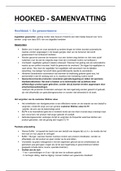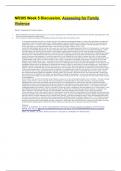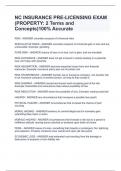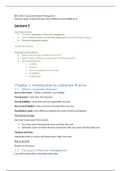Package deal
Portage Learning Chem 210 - Module1 -8 Problem Set with 100% verified answers-
Portage Learning Chem 210 - Module1 -8 Problem Set with 100% verified answers-
[Show more]Portage Learning Chem 210 - Module1 -8 Problem Set with 100% verified answers-
[Show more]Question 1 0 / 0 pts What is the shape of water? Bent. The bond angle is 104.5 degrees. Question 2 0 / 0 pts What is autoionization, and how is it important for water? Autoionization is the ability of a compound to react with itself to form ions. One water molecule reacts with a second molec...
Preview 2 out of 7 pages
Add to cartQuestion 1 0 / 0 pts What is the shape of water? Bent. The bond angle is 104.5 degrees. Question 2 0 / 0 pts What is autoionization, and how is it important for water? Autoionization is the ability of a compound to react with itself to form ions. One water molecule reacts with a second molec...
Question 1 0 / 0 pts Is the following molecule an aldose or ketose? Briefly explain. ketose. There is a C=O on the third carbon from the top. Question 2 0 / 0 pts Which carbon in erythrose would tell you if the monosaccharide is D or L? Give the carbon’s number in your answer. On carbon nu...
Preview 2 out of 7 pages
Add to cartQuestion 1 0 / 0 pts Is the following molecule an aldose or ketose? Briefly explain. ketose. There is a C=O on the third carbon from the top. Question 2 0 / 0 pts Which carbon in erythrose would tell you if the monosaccharide is D or L? Give the carbon’s number in your answer. On carbon nu...
Question 1 0 / 0 pts Name three different functions of proteins. Transport, hormones, catalysis, structure, and protection Question 2 0 / 0 pts What function does a protease have? catalysis. It degrades proteins. Question 3 0 / 0 pts What is the function of hormones? These proteins commun...
Preview 2 out of 7 pages
Add to cartQuestion 1 0 / 0 pts Name three different functions of proteins. Transport, hormones, catalysis, structure, and protection Question 2 0 / 0 pts What function does a protease have? catalysis. It degrades proteins. Question 3 0 / 0 pts What is the function of hormones? These proteins commun...
Question 1 0 / 0 pts How is the definition of lipid different from protein and carbohydrate? The lipid definition is based on the functional definition of being soluble in a non-polar solvent. Proteins and carbohydrates are based on the structure. Question 2 0 / 0 pts What are three function...
Preview 2 out of 5 pages
Add to cartQuestion 1 0 / 0 pts How is the definition of lipid different from protein and carbohydrate? The lipid definition is based on the functional definition of being soluble in a non-polar solvent. Proteins and carbohydrates are based on the structure. Question 2 0 / 0 pts What are three function...
Question 1 0 / 0 pts What is the difference between a nucleoside and nucleotide? A nucleoside is formed from the covalent bonding of a base, purine or pyrimidine, to either ribose or 2-deoxyribose. Nucleotides are built from a nitrogen-containing organic base, a monosaccharide, and phosphate. ...
Preview 2 out of 5 pages
Add to cartQuestion 1 0 / 0 pts What is the difference between a nucleoside and nucleotide? A nucleoside is formed from the covalent bonding of a base, purine or pyrimidine, to either ribose or 2-deoxyribose. Nucleotides are built from a nitrogen-containing organic base, a monosaccharide, and phosphate. ...
Question 1 0 / 0 pts A scientist uses the term flux regarding a biochemical pathway. What does flux mean? Flux is the rate of flow through a biochemical pathway. Question 2 0 / 0 pts A particular pathway breaks down proteins into amino acids. Is this an anabolic or a catabolic pathway? Catab...
Preview 2 out of 10 pages
Add to cartQuestion 1 0 / 0 pts A scientist uses the term flux regarding a biochemical pathway. What does flux mean? Flux is the rate of flow through a biochemical pathway. Question 2 0 / 0 pts A particular pathway breaks down proteins into amino acids. Is this an anabolic or a catabolic pathway? Catab...
Question 1 0 / 0 pts What is the “unifying” theory covered in this module? Chemiosmotic theory Question 2 0 / 0 pts How many ATP are produced per NADH molecule? Per FADH2 molecule? NADH produced 2.5 ATP, while produces FADH21.5 ATP. Question 3 0 / 0 pts In the figure below, several por...
Preview 2 out of 5 pages
Add to cartQuestion 1 0 / 0 pts What is the “unifying” theory covered in this module? Chemiosmotic theory Question 2 0 / 0 pts How many ATP are produced per NADH molecule? Per FADH2 molecule? NADH produced 2.5 ATP, while produces FADH21.5 ATP. Question 3 0 / 0 pts In the figure below, several por...
Question 1 0 / 0 pts What are three ways that biochemists study biological organisms? Biochemists study 1) the relationship between structure and function of biomolecules, 2) chemical reactions of organisms (metabolism), and 3) communication within and among organisms. Question 2 0 / 0 pts W...
Preview 2 out of 8 pages
Add to cartQuestion 1 0 / 0 pts What are three ways that biochemists study biological organisms? Biochemists study 1) the relationship between structure and function of biomolecules, 2) chemical reactions of organisms (metabolism), and 3) communication within and among organisms. Question 2 0 / 0 pts W...
The pH of a solution of 8.9 x 10-12 M NaOH is: A. 8.9 B. 8.9 x 10-12 C. 4.8 D. 11 E. 2.9 A B C D Correct! E [Kw=[H+][OH-] = 1.0 x 10-14; [H+][8.9 x 10-12] = 1.0 x 10-14 ;[H+]=890; pH=-log[890]=2.9] Question 2 3 / 3 pts Water is a unique molecule. Which of the following contribut...
Preview 3 out of 17 pages
Add to cartThe pH of a solution of 8.9 x 10-12 M NaOH is: A. 8.9 B. 8.9 x 10-12 C. 4.8 D. 11 E. 2.9 A B C D Correct! E [Kw=[H+][OH-] = 1.0 x 10-14; [H+][8.9 x 10-12] = 1.0 x 10-14 ;[H+]=890; pH=-log[890]=2.9] Question 2 3 / 3 pts Water is a unique molecule. Which of the following contribut...
Question 1 3 / 3 pts True or False: According to the Module, a compound with a molecular mass of 3,000 g/mol is considered a macromolecule. FALSE Question 2 3 / 3 pts True or False: Biomolecules can have only two functional groups. FALSE Question 3 0 / 3 pts True or False: The following f...
Preview 2 out of 11 pages
Add to cartQuestion 1 3 / 3 pts True or False: According to the Module, a compound with a molecular mass of 3,000 g/mol is considered a macromolecule. FALSE Question 2 3 / 3 pts True or False: Biomolecules can have only two functional groups. FALSE Question 3 0 / 3 pts True or False: The following f...
Question 1 3 / 3 pts True or False: The amino acids serine and threonine both contain sulfur atoms. FALSE Question 2 3 / 3 pts True or False: The following secondary structure shown below is an example of a betaturn. FALSE Question 3 3 / 3 pts True or False. The side chain of phenylalanine...
Preview 2 out of 11 pages
Add to cartQuestion 1 3 / 3 pts True or False: The amino acids serine and threonine both contain sulfur atoms. FALSE Question 2 3 / 3 pts True or False: The following secondary structure shown below is an example of a betaturn. FALSE Question 3 3 / 3 pts True or False. The side chain of phenylalanine...
In RNA, guanine always pairs with ________. Thymine Guanine Cytosine Uracil Both A and B CYSTOSINE Question 2 3 / 3 pts DNA is built from which of the following? Nucleosides Genes Purines Nucleotide Codons NUCLEOTIDE Question 3 3 / 3 pts The Z-form helix of DNA is stabili...
Preview 3 out of 16 pages
Add to cartIn RNA, guanine always pairs with ________. Thymine Guanine Cytosine Uracil Both A and B CYSTOSINE Question 2 3 / 3 pts DNA is built from which of the following? Nucleosides Genes Purines Nucleotide Codons NUCLEOTIDE Question 3 3 / 3 pts The Z-form helix of DNA is stabili...
Which of the following monosaccharides is a ketose? Correct! Dihydroxyacetone Galactose Glucose Glyceraldehyde Idose Dihydroxyacetone Question 2 3 / 3 pts When two carbohydrates are epimers: One is a pyranose, the other a furanose One is an aldose, the other a ketose They differ...
Preview 3 out of 16 pages
Add to cartWhich of the following monosaccharides is a ketose? Correct! Dihydroxyacetone Galactose Glucose Glyceraldehyde Idose Dihydroxyacetone Question 2 3 / 3 pts When two carbohydrates are epimers: One is a pyranose, the other a furanose One is an aldose, the other a ketose They differ...
Glycerol contains how many alcohol functional groups? 1 2 3 4 None of the above 3 Question 2 3 / 3 pts Which of the following are derived from or made from fatty acids? Cholesterol Carotenoids Phosphoglycerides Both A and B Both A and C PHOSPHOGLYCERIDES Question 3 3 / 3 p...
Preview 2 out of 12 pages
Add to cartGlycerol contains how many alcohol functional groups? 1 2 3 4 None of the above 3 Question 2 3 / 3 pts Which of the following are derived from or made from fatty acids? Cholesterol Carotenoids Phosphoglycerides Both A and B Both A and C PHOSPHOGLYCERIDES Question 3 3 / 3 p...
Question 1 3 / 3 pts True or False: Nitrogen is called the superglue of the chemical world. FALSE Question 2 3 / 3 pts True or False: Large elements, such as strontium, are common in biomolecules. FALSE Question 3 3 / 3 pts True or False: The time it takes for a compound to flow through a ...
Preview 2 out of 14 pages
Add to cartQuestion 1 3 / 3 pts True or False: Nitrogen is called the superglue of the chemical world. FALSE Question 2 3 / 3 pts True or False: Large elements, such as strontium, are common in biomolecules. FALSE Question 3 3 / 3 pts True or False: The time it takes for a compound to flow through a ...
Question 1 3 / 3 pts True or False: The majority of reactions of the urea cycle occur in the cytosol. TRUE Question 2 3 / 3 pts True or False: NADH yields 1.5 ATP molecules after donating electrons and hydrogen atoms to the electron transfer chain (ETC). FALSE Question 3 3 / 3 pts True or...
Preview 2 out of 12 pages
Add to cartQuestion 1 3 / 3 pts True or False: The majority of reactions of the urea cycle occur in the cytosol. TRUE Question 2 3 / 3 pts True or False: NADH yields 1.5 ATP molecules after donating electrons and hydrogen atoms to the electron transfer chain (ETC). FALSE Question 3 3 / 3 pts True or...

Stuvia customers have reviewed more than 700,000 summaries. This how you know that you are buying the best documents.

You can quickly pay through credit card or Stuvia-credit for the summaries. There is no membership needed.

Your fellow students write the study notes themselves, which is why the documents are always reliable and up-to-date. This ensures you quickly get to the core!
You get a PDF, available immediately after your purchase. The purchased document is accessible anytime, anywhere and indefinitely through your profile.
Our satisfaction guarantee ensures that you always find a study document that suits you well. You fill out a form, and our customer service team takes care of the rest.
Stuvia is a marketplace, so you are not buying this document from us, but from seller Studygreatsolutions. Stuvia facilitates payment to the seller.
No, you only buy these notes for $30.49. You're not tied to anything after your purchase.
4.6 stars on Google & Trustpilot (+1000 reviews)
94340 documents were sold in the last 30 days
Founded in 2010, the go-to place to buy study notes for 14 years now



